I love my African Violets and currently have over 50 of them! Yes I have a problem, but admitting it is the first step right? African Violets have a bad reputation for being difficult although if you know just a few easy steps on how to care for them they reward you with beautiful blooms of every color!
African violets are a type of flowering plant native to tropical climates. They’re popular houseplants, thanks to their bright flowers and low maintenance requirements. Growing African violets is easy if you follow the right steps. Here’s how you can successfully grow these beautiful plants in your home.
African Violets
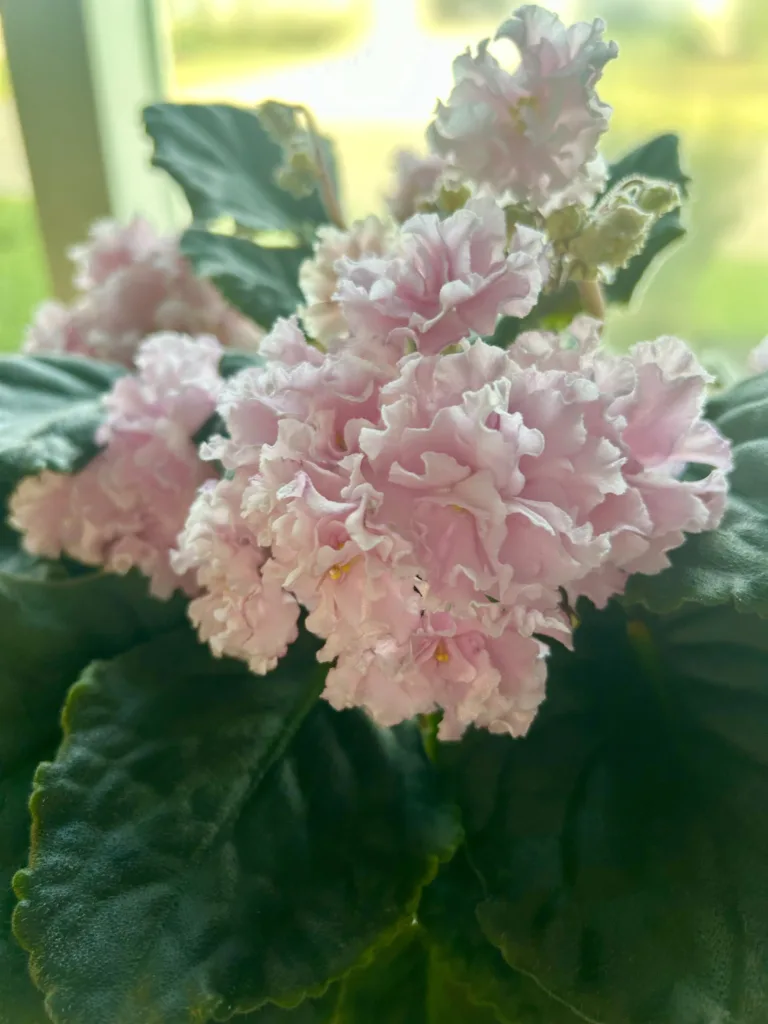
Are you fascinated by the world of African violets? From the delicate flowers, it’s no wonder these majestic plants have captivated the hearts of gardeners everywhere! With care, patience, and a few expert tips, you can learn how to take your African violet gardening game to the next level – and enjoy beautiful blooms all year round.
Whether you’re looking for easy maintenance tips or advanced watering schedules, this blog post will provide you with all the advice and guidance needed to achieve success as an African violet gardener! Leaves can be solid green or variegated green and white and either smooth or quilted/wavy or frilly. Finally they come in a variety of sizes which will help you determine the pot size you will need.
Choose your plant
When selecting an African Violet, look for healthy looking plants with dark green leaves and vibrant blooms. Avoid any plants that have yellowing or wilted leaves as this may indicate a pest infestation or disease. If possible, try to select a plant that has multiple buds so that it will flower for longer.
African Violet Sizes
African Violets are a wonderful addition to any home and come in many different sizes. Full-sized African violets range from small, to medium, and large. There is also the option of miniatures, which often appear similar to full-sized African violets but are much smaller. Trailers are closely related to the African violet family, although they have trailing vines instead of rosettes. Finally, micro miniatures offer more intricate shapes and colors than their regular miniature African Violet relatives. African Violets can be quite beautiful when cared for properly and there’s sure to be a variety that fits everyone’s needs perfectly!
Best light for African Violets
African Violets need bright, indirect light to thrive indoors and produce flowers year-round. The best spot in your home will depend on orientation; south-facing windows provide more direct sunlight whereas east-facing windows provide more diffused light throughout the day which is better for plants like African violets which prefer indirect sunlight rather than direct sun rays hitting their delicate petals directly throughout the day. They do not like direct sunlight as this will cause the leaves to yellow and the plant will die.
It is said the best window for African Violets is a South facing window. Although I have mine in South, North and West windows along with a few under grow lights. On my North and West windows I do partially close my blinds a little allowing only filtered light. You can also use a shear curtain to filter the light if you don’t have blinds. Some of my Violets’s thrive best in North window but tend to wither in South window. So I just move them around and see where they want to bloom and grow best. I have a post just on the different types of lights for African Violets that you can read by clicking here.
Grow Lights for African Violets
My grow lights are at least 12″ above my plants and set on 12 hours on and 12 hours off. These Foxgarden full spectrum light strips are perfect. I have owned two of them for over a year now with no issues at all. My violets are doing great under these grow lights and bloom continuously without fail!
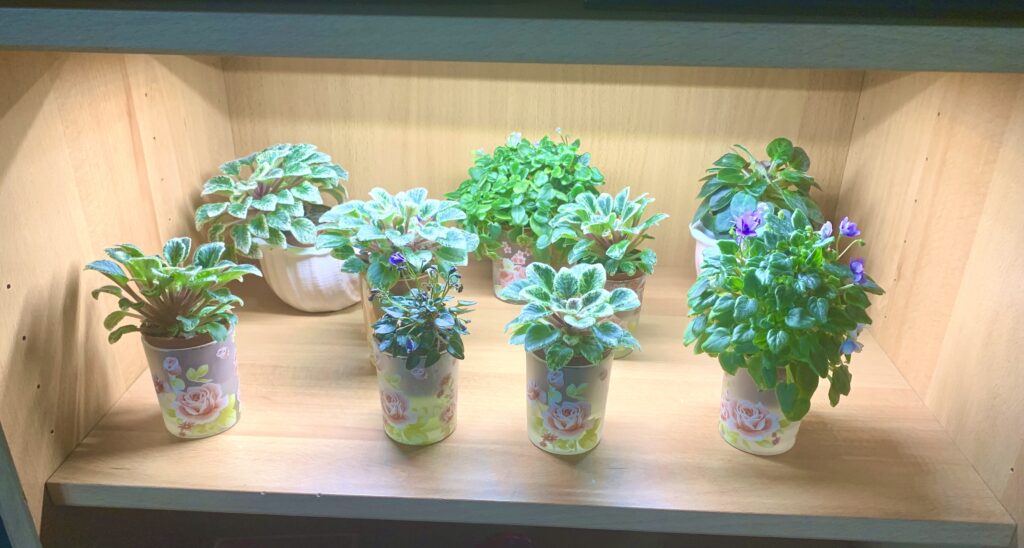
African Violet Pots – African Violet Planters
African Violets prefer shallow pots with drainage holes at the bottom and plenty of room around the sides for roots to grow. Clay or ceramic pots are best as they help keep soil moist while also providing good air circulation to the roots.
Just like children or pets every African Violet is different. The best pot for one African violet may not work for the next. I have transplanted more than one African Violet that was suffering in its current pot. Once transplanted it flourished! So don’t be afraid to experiment, as with lighting move them around until they are happy! You do what works not only for you and your circumstances but also for the health of the African Violet.
Pot Sizes
It can be tricky to figure out the best pot size for your African Violet, as each size needs a specific one. Generally, for a micro-miniature African Violet, you should use a pot no larger than 2 inches in diameter, while a miniature will do best with a pot between 2-3 inches. For small African Violets you can use a pot that is 3-4 inches in diameter and medium ones should have pots at least 4-5 inches wide. And lastly, large African Violets need to be planted in pots that are 5 or more inches in width.
Picking the right size of the pot is essential for keeping your beloved plants healthy and thriving! African Violets like to be slightly root bound although when they are growing out of the bottom it’s time to move them up a size! If you do water wicking for your African Violets these Greenpara Transparent Pots are great, you can see your roots and they come in various sizes in one package. These Mintra 4 pack of pots come in a variety of colors and range from 4″ up to 7″.
African Violet Self Watering Pots or Water Wicking Pots
A majority of my African Violets are in water wicking pots. You can buy many different types of water wicking pots like this 3 pack of clear water wicking pots or these Santino Calypso 3 pack that come in a variety of colors. Or if you prefer to make your own like I do then you can use these 4″ pots, I love the variety of colors and I can write the name of the African Violet on the pot with a sharpie. Next I put a piece of yarn, split into either two or three strands so not too much water is absorbed, long enough to touch the water, come up through holes in bottom of pot and up to the top of your pot.
These screens are perfect for the bottom of the pot to keep the soil from falling out of the holes. Finally I put them in one of these glass bowl vases that hold the water. I have even started coloring the outside of these vases with this alcohol ink!
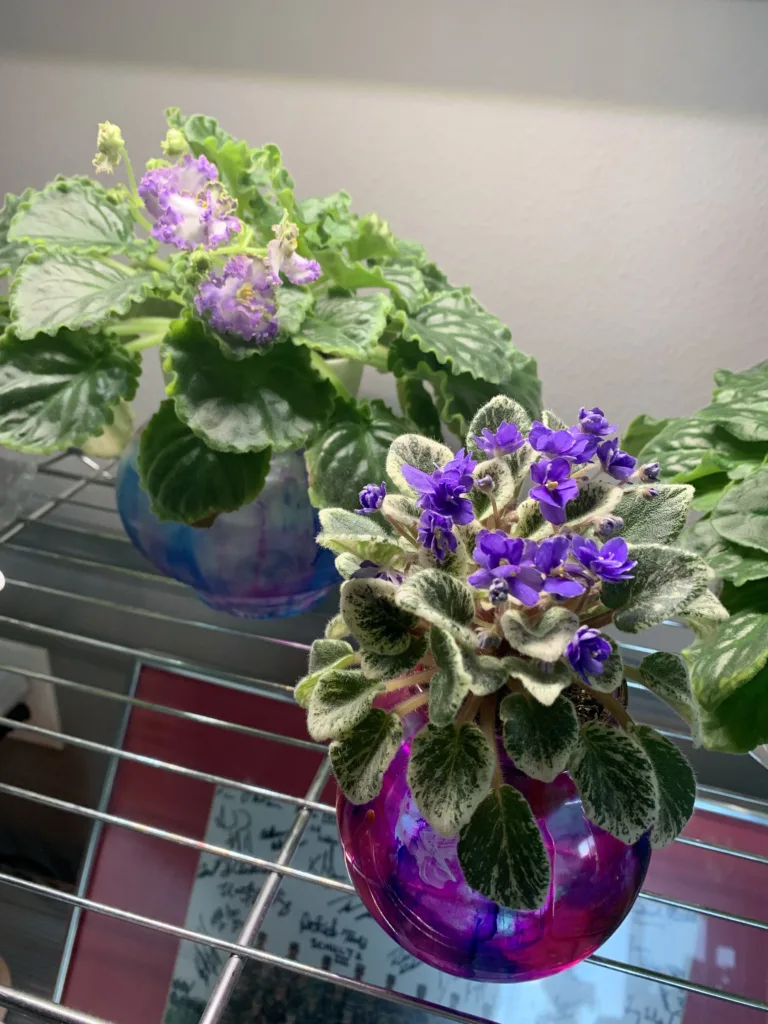
Two of the glass bowl vases I mentioned above that I colored with alcohol ink – I love how they turned out! You can see multiple videos on YouTube on how to use Alcohol Ink on vases.
Water Wicking for Trailers, Micro-Miniature and Miniature African Violets
My latest obsession is trailers, miniature and micro-miniature African Violets and they are in water wicking pots I created. I use these 2″ plastic pots with screens on the bottom, piece of 3 strands of acrylic yarn for my wick. And finally put them in shot glasses, I love these beautiful cut glass vases! Trailers differ from the other African Violets as they have multiple crowns. Where all other Violets grow from a center crown, trailers continue to grow and can have multiple crowns causing them to spread wider and wider! I have some in 2″ pots and others in a 4″ shallow pot-the possibilities are endless with trailers!
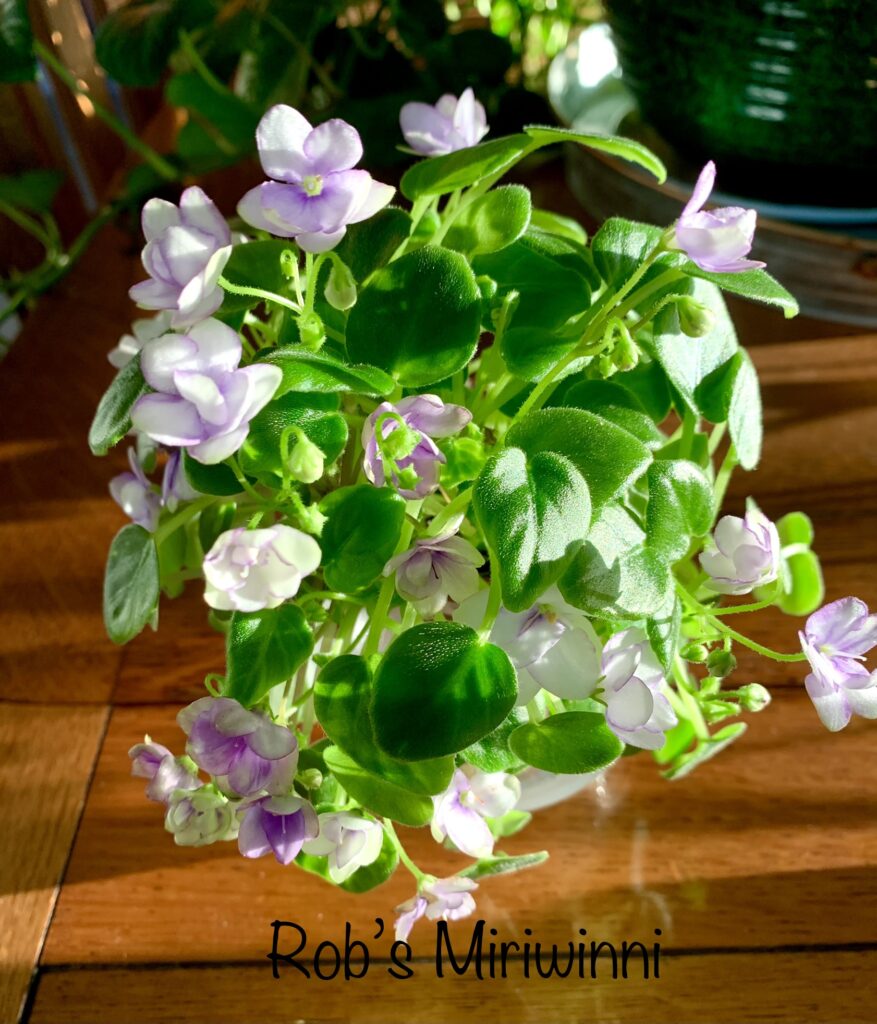
One of my favorite trailers called Rob’s Miriwinni. This is in a shot glass although due to the multiple crowns you can’t even see it! This one is very easy to start new ones from the leaves-I have given away so many of these.
Ceramic African Violet Pots
I also have some that thrive better in ceramic African Violet pots. There are a variety of these, they last forever and you buy in multiple colors to match your decor. They have a ceramic outer pot that holds the water and an inner porous pot that slowly absorbs the water and keeps your soil moist. Here are just a few of my favorites – Laughing Moose Ceramic African Violet pot, Repotme Teardrop African Violet pot and finally this White Glazed African Violet pot that will match any decor.
Pots with Trays
And finally I have few in a regular pot with a saucer, these are watered from the bottom. I love this assortment of colored 4″ pots with matching saucers or you can even put a large assortment of pots on a metal tray with a layer of stones, fill the tray with water weekly to water your violets and promote humidity which they love!
How often do you repot your African Violet?
I care for my African Violets by repotting them once a year to give them fresh soil. If I have them in plastic pots for water wicking then I also give them a fresh pot. For my Violets in ceramic African Violet pots then I remove the plant, clean the ceramic inner pot and then repot with fresh soil. If your inner ceramic pot is not taking in water like it should you can soak it in a mixture of half white vinegar and half water for 30-60 minutes. This will open up the porous inner pot that can build up with minerals and allow water to seep in to the roots again and keep the plant healthy. Also once they are full grown you just repot in the same size pot they were in.
Fertilizing African Violets
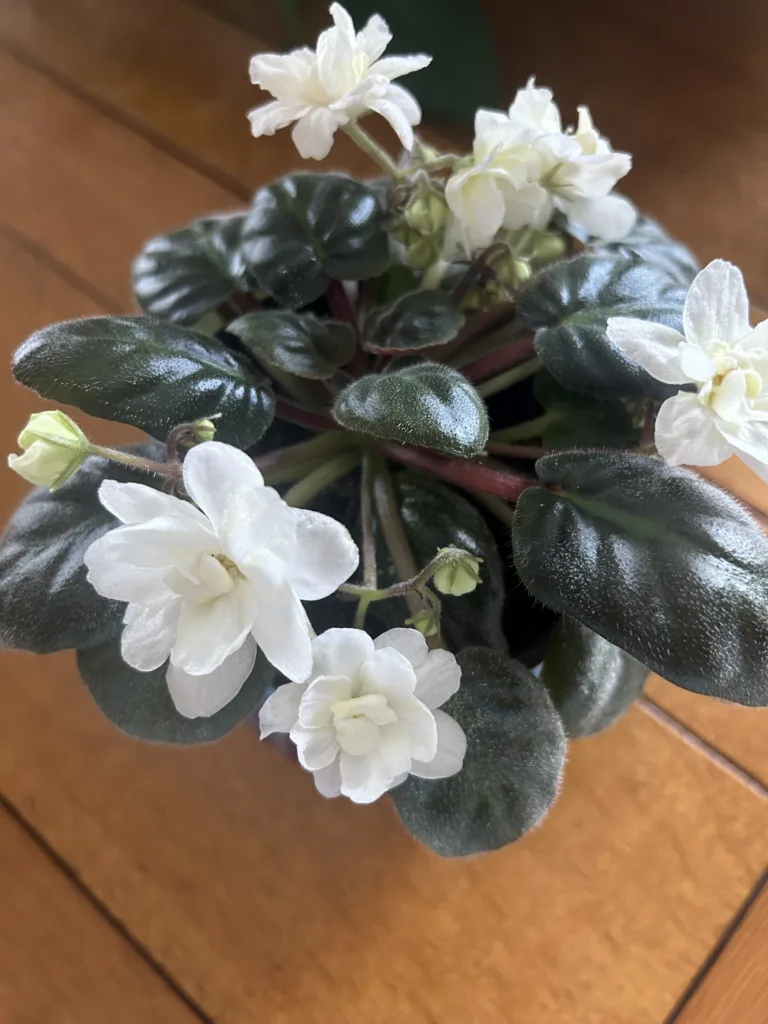
Fertilize Regularly – African violets need regular fertilizing to reach their full potential – once every two weeks during spring/summer months and once per month during fall/winter months is ideal depending on how often you water them (more frequent fertilizing may be necessary if you are watering daily). Choose a fertilizer specifically designed for flowering plants such as African Violets as these have higher levels of phosphorus which helps promote healthy flower growth and development over time. My favorite African Violet fertilizer is Schultz AV liquid fertilizer.
Propagating African Violets
Propagating African Violets is easier than you think. You can do this multiple ways and everyone has their favorite, you do what works for you. You want to get a leaf from the middle row of leaves and cut the end off at an angle with a clean sterilized knife. I wipe my knife down with alcohol and let it air dry. Then you can dip the leaf in rooting hormone and put it in African Violet potting soil. My Dad always started his in perlite only until they rooted and small new leaves began to show. He then moved them on to a pot of African Violet potting soil.
Propagating African Violets in water.
I start my African Violets in water, I have a wooden holder that holds 4 test tubes and I fill them with purified water and put my leaves in there until I get a long set of roots, this usually takes 2-3 weeks. Then I pot them in a 4″ pot of African Violet soil. You can also use any vase or cup you want by putting saran wrap over them, secure with a rubber band and poke holes so only the stem goes through to the water.
Here are a few of my favorite propagation stands and even a few hanging ones! Foosibo wooden and glass tube stand, Mkono Desktop propagation stand, Creproly wire and glass Propagation Stand, Mkono Boho macrame and glass wall hanging propagation center and finally Mkono 3 tiered wood and glass hanging plant hanger. There are so many more and when you click on any of these you will find pages of propagation stations!
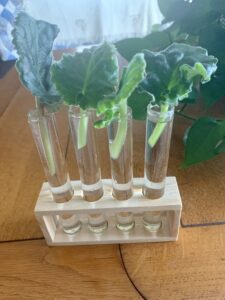
Dividing African Violets
Many African Violets will duplicate as they grow and get what is called suckers or new plants started at the base of the plant.
African Violets can easily be propagated by division. In time, these plants will produce sucker-like shoots around the base of the main plant. These are baby plants that have been produced from asexual propagation and are also known as offsets or plantlets. When enough of these have formed, it is time to divide your African Violet and transplant them into their containers.
Start by removing each baby plant from the main parent plant with a sterile sharp knife or pair of shears (I clean mine with alcohol and let them air dry). Cut as close to the base as possible, making sure to keep some roots attached to each sucker.
Once you have all your offsets, use a potting mix made specifically for African Violets and fill small containers with the soil. Plant each sucker in the container and pack it down gently so that they are secure. Water them well and place them in a sunny spot where they can get some indirect sunlight or artificial light if using grow lights.
With proper care and attention, these offsets will eventually become beautiful African Violets in their own right. Dividing your plant can be a great way to share the beauty of the African Violet with friends and family!
African Violet Soil
African violets need well-drained soil that is rich in organic matter and nutrients. Good quality potting soil mixed with compost is ideal for growing healthy plants. You can also buy a special African violet mix from your local gardening store which contains all the necessary ingredients for optimal growth.
Everyone has their favorites. I started with store bought African Violet potting soil like Miracle Grow African Violet soil or Black Gold African Violet soil that you can purchase at your favorite garden center or online at Amazon. Now with so many African Violets I have come up with my own mixture of 2 parts sphagnum peat moss, 1 part perlite and 1 part vermiculite. You should use the soil that works for you and makes your African Violets happy.
African Violet Water and How Often to water your African Violets
The key to successful watering is consistency – water your plants when they are dry, but be careful not to overwater them as this can lead to root rot and other diseases. The best way to tell if your plant needs watering is by feeling the soil – it should be slightly damp but not wet or saturated with water when touched lightly with your fingertips. I have a blog post written solely for how to water African Violets and you can read it by clicking here.
I water my African Violets weekly with tap water that I let sit for 24 hours first. In one gallon of water I put 1 Tablespoon of hydrogen peroxide (to cut down on algea growth in my glass water wicking pots) and 2-3 droppers of Schultz African Violet food. You want to keep your soil moist but not overly wet. A majority of my African Violets are in water wicking pots and I replace the water weekly. My Violets in Ceramic African Violet pots I just top off the water in the outer pot weekly. And finally those in trays I just add enough water the reach bottom of pot and let them absorb the water from the bottom.
Problems with African Violets
African Violets can be a bit finicky at times but once you find out where they are happy they reward you with year round blooms and beautiful foliage!
Cupping of Leaves – This can be caused by your African Violet being too cold, happens allot when placed in North windows. Especially at night when the temperature drops and the wind blows. Most Violets don’t like temperatures cooler than 65 F. Different cultivars react differently so while one looks fine and the other starts cupping of leaves or has a tight center growth then just move it to a different window. You might want to invest in a temperature monitor like this ThermoPro and it will let you know how warm and cool the plants are in a 24 hour period.
African Violet Leaves Drooping – This happens when the soil is too wet or if it’s not watered enough. Just make sure your soil is moist, not dry to the touch or soggy and saturated with water.
Spotting on Leaves – This can be caused by water damage to the leaf. You should never mist your African Violets. Also try to never get water on the foliage as this will cause permanent leaf spotting.
Happy Gardening!
African Violets come in an impressive variety of shapes and sizes, allowing you to find one that suits both your decorating style and place in the home. With their varying hues of purple, pink, white, and yellow blooms, African Violets are sure to brighten up any room of the home with their delicate beauty.
Please be sure to check out my Gardening Blog Post Page for more tips on all types of gardening. Including Seed Saving, Seed Starting, Orchids, Water Gardening, Coldframe Gardening, Indoor Bulb Gardening, Hydroponics, Container Gardening, Mums, Herbs, African Violets, planting Bulbs, Flower Gardening, Vegetable and Fruit Gardening, Indoor Houseplants of all kinds, Cactus, Succulents, Hanging plants, Deer resistant plants and even Bird, Bee, Butterfly and Hummingbird Gardens!
